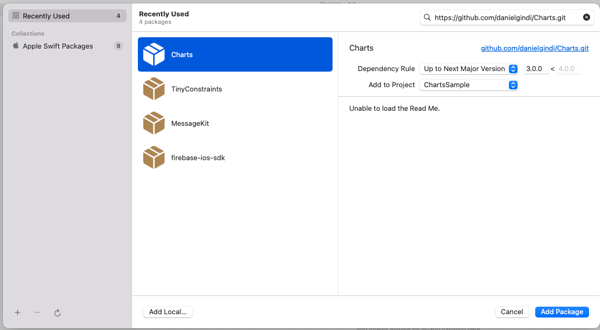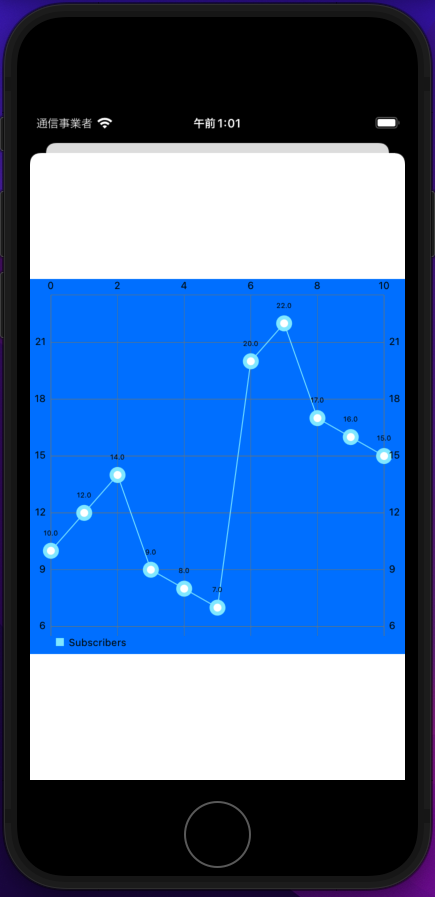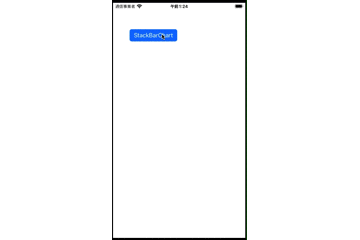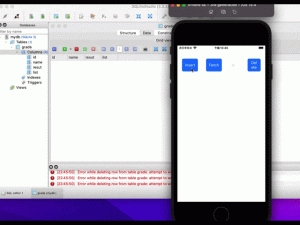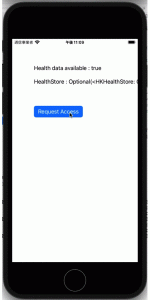Swift iOSにチャートを組み込む
グラフ用のライブラリを読み込んで、グラフを表示させる。
XCode プロジェクトのコンテキストメニューから、Add Package を選択し、上記GiHubリポジトリのURLをダイアログの検索窓に入力。
https://github.com/danielgindi/Charts.git
Add Packageで利用可能になる。
GiHubのトップページにある、チュートリアルを見ながら実装していく。
TinyConstraingsというパッケージも上記チュートリアルで追加しているのだが、なかなかわかりにくい、AutoLayoutをコードで簡潔に設定できるライブラリのようだ。
https://github.com/roberthein/TinyConstraints.git
もCharts同様に、Add Packageしておく。
1.基本的なグラフ
チュートリアルにしたがい、以下のような適当なグラフを作成してみる。
import UIKit import Charts import TinyConstraints // // https://www.youtube.com/watch?v=mWhwe_tLNE8&list=PL_csAAO9PQ8bjzg-wxEff1Fr0Y5W1hrum&index=6 // class LineChartViewController: UIViewController, ChartViewDelegate { lazy var lineChartView: LineChartView = { let charView = LineChartView() charView.backgroundColor = .systemBlue return charView }() override func viewDidLoad() { super.viewDidLoad() // Do any additional setup after loading the view. view.addSubview(lineChartView) lineChartView.centerInSuperview() lineChartView.width(to: view) lineChartView.heightToWidth(of: view) setData() } func chartValueSelected(_ chartView: ChartViewBase, entry: ChartDataEntry, highlight: Highlight) { print(entry) } func setData() { let set1 = LineChartDataSet(entries: yValues, label: "Subscribers") let data = LineChartData(dataSet: set1) lineChartView.data = data } let yValues: [ChartDataEntry] = [ ChartDataEntry(x: 0.0, y: 10.0), ChartDataEntry(x: 1.0, y: 12.0), ChartDataEntry(x: 2.0, y: 14.0), ChartDataEntry(x: 3.0, y: 9.0), ChartDataEntry(x: 4.0, y: 8.0), ChartDataEntry(x: 5.0, y: 7.0), ChartDataEntry(x: 6.0, y: 20.0), ChartDataEntry(x: 7.0, y: 22.0), ChartDataEntry(x: 8.0, y: 17.0), ChartDataEntry(x: 9.0, y: 16.0), ChartDataEntry(x:10.0, y: 15.0) ] }
2.いろいろ設定を弄る
上記で作成したソースに、おもにcharViewを生成したところで各種プロパティを変更、また、DataSetとDataのプロパティも触って、以下のようなアニメーション含みのグラフにすることができた。
import UIKit import Charts import TinyConstraints // // https://www.youtube.com/watch?v=mWhwe_tLNE8&list=PL_csAAO9PQ8bjzg-wxEff1Fr0Y5W1hrum&index=6 // class LineChartViewController: UIViewController, ChartViewDelegate { lazy var lineChartView: LineChartView = { let charView = LineChartView() charView.backgroundColor = .systemBlue // Customize start charView.rightAxis.enabled = false let yAxis = charView.leftAxis yAxis.labelFont = .boldSystemFont(ofSize: 12) yAxis.setLabelCount(6, force: false) yAxis.labelTextColor = .white yAxis.axisLineColor = .white yAxis.labelPosition = .insideChart let xAxis = charView.xAxis xAxis.labelPosition = .bottom xAxis.labelFont = .boldSystemFont(ofSize: 12) xAxis.setLabelCount(6, force: false) xAxis.labelTextColor = .white xAxis.axisLineColor = .systemBlue charView.animate(yAxisDuration: 2.5) // Customize end return charView }() override func viewDidLoad() { super.viewDidLoad() // Do any additional setup after loading the view. view.addSubview(lineChartView) lineChartView.centerInSuperview() lineChartView.width(to: view) lineChartView.heightToWidth(of: view) setData() } func chartValueSelected(_ chartView: ChartViewBase, entry: ChartDataEntry, highlight: Highlight) { print(entry) } func setData() { let set1 = LineChartDataSet(entries: yValues, label: "Subscribers") // Customize start set1.mode = .cubicBezier set1.drawCirclesEnabled = false set1.lineWidth = 3 set1.setColor(.white) set1.fill = Fill(color: .white) set1.fillAlpha = 0.8 set1.drawFilledEnabled = true // Customize end let data = LineChartData(dataSet: set1) // Customize start data.setDrawValues(false) // Customize end lineChartView.data = data } let yValues: [ChartDataEntry] = [ ChartDataEntry(x: 0.0, y: 10.0), ChartDataEntry(x: 1.0, y: 12.0), ChartDataEntry(x: 2.0, y: 14.0), ChartDataEntry(x: 3.0, y: 9.0), ChartDataEntry(x: 4.0, y: 8.0), ChartDataEntry(x: 5.0, y: 7.0), ChartDataEntry(x: 6.0, y: 20.0), ChartDataEntry(x: 7.0, y: 22.0), ChartDataEntry(x: 8.0, y: 17.0), ChartDataEntry(x: 9.0, y: 16.0), ChartDataEntry(x:10.0, y: 15.0) ] }
